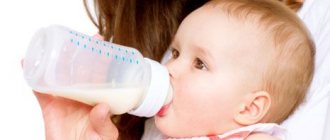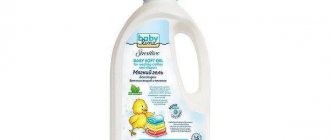Mother's milk is the best and natural product for feeding a baby. With it he receives all the necessary nutrients, fats, vitamins.
But there are situations when there is not enough milk or the mother needs to leave often. In this case, pediatricians recommend not switching the baby to artificial feeding, but introducing supplementary feeding with an adapted milk formula. Goat milk based is best.
Please note that there is a difference in the concepts of “supplementary feeding” and “complementary feeding”. Complementary feeding is the introduction of crumbs of different foods to the menu: fruits, vegetables, soups, etc. etc. It is introduced at about six months, not earlier. Supplementary feeding is the addition of crumbs of formula to the diet to compensate for the lack of breast milk. The baby is fed additionally if necessary, sometimes from the first day of life. We will tell you below how to properly introduce supplementary feeding during breastfeeding.
Should I use supplementary feeding while breastfeeding?
The type of feeding in which the child receives breast milk and at least 150 ml of artificial nutrition per day is called mixed.
This situation has advantages compared to a completely artificial type of feeding. Lactation does not fade, and it is possible to refuse supplementary feeding.
The mixture as an additional power source is needed in the following cases:
- Hypogalactia (insufficient production of breast milk).
- Illness of a nursing mother (for serious illnesses, when a woman takes medications that are not compatible with breastfeeding, or requires hospitalization).
- Forced separation (mom had to leave for a long time, and there was not enough supply of expressed breast milk).
- Underweight (pediatricians focus on the lower weight limit. If the baby is clearly underweight, this means that he does not have enough nutrition).
- Prematurity (children born much prematurely are physically unable to fully breastfeed).
- Premature cessation of lactation.
- Lack of breast milk in a postpartum mother.
Is it necessary to introduce it or is it possible to restore lactation?
If the child clearly suffers from a lack of breast milk (loses or does not gain weight), then it is impossible to do without introducing a certain amount of formula. To check whether the baby has sufficient body weight, special tables with indicators for children in the first year of life will help.
If interruptions in breast milk occurred because the mother was very stressed, very tired, or was poisoned by something, then you should wait with supplementary feeding and direct all efforts to restore natural feeding in full. To do this, a nursing woman should drink a lot of warm liquid . It is also important to make adjustments to your diet and get more rest.
Some mothers believe that the introduction of supplementary feeding is the first step towards artificial feeding. Everything is not so clear. If a nursing mother supports the production of breast milk in every way and tries in every possible way to strengthen this process, then lactation will not fade.
It is important to consider that the body will not stop producing milk if the proportion of formula in the daily diet does not exceed 30-50%.
choosing a formula for a newborn
I would like to share the link: Rental of baby scales in Perm
This name usually refers to electronic scales for weighing newborns, which you can either buy or rent in Perm. The range of online stores for baby scales cannot be called very wide.
But the fact is that the meaning of this essential item for a newborn does not change depending on what kind of support for the child is on the scales or what color the buttons on the panel are: baby scales will weigh a child up to 15-20 kg, and in measurement increments of 1-10 G . Only kitchen scales weigh with such discreteness in everyday life, but it’s a shame that we cannot place a newborn on the small bowls of these scales. The same goes for accurately weighing it on a bathroom scale. Simply because on ordinary floor scales the measuring step is usually 100 g.
For newborn babies, who only weigh about 3 kg, values of 10, 20 g are quite a lot. But parents definitely need to know important numbers about how their child is gaining weight. Because a newborn’s weight gain is one of the most important indicators of his health and development.
When we learn in the maternity hospital or from the local doctor that electronic scales are needed to weigh a newborn, we go looking for them in pharmacies and stores, trying to figure out along the way what kind of scales are needed for the baby?
In fact, the choice is much easier to make than choosing a mobile phone or TV. There are a ton of technical specifications there - until you figure them all out!
Among children's electronic scales, there is nothing special to understand.
- The first is the measurement step.
- The second is ease of use.
- Third - buy or rent.
So, scales with a measurement step of 10g. This means that on the display you will see the child’s weight, for example, 3kg 520g or 530g. They won't show you 536g, for example. They will round everything up to the nearest ten grams. When the baby moves on the scales, such scales will show you with an accuracy of +- 10 g. They can show +-20 g if the little one is fidgeting very actively there.
Scales with 5g increments will round the numbers to 5g. It happens that up to 10 years.
But scales with a measurement step of 1g are no longer ordinary household scales for newborns. This is professional medical equipment. And they cost the same as professional equipment – that is, an order of magnitude higher.
If the smallest numbers of how much the baby ate from the breast during feeding are very important to you in order to calculate how much formula to feed him, then on the “Sasha” scales - that’s the name of the model with a measurement step of 1g, you will be able to see the most accurate numbers. There are no other models with a resolution of 1 g in Russia.
And if there is, then this is Japanese equipment, which is 4 times more expensive than these scales.
Such scales should definitely be taken for premature babies with low weight or if you understand that the child is losing weight, not gaining weight and you need to know the exact numbers to understand the real picture.
Ease of use. The main points here include the automatic recording of weight during the weighing of children and whether the scales show a difference from the previous weighing. Or you will need to write it down on paper each time and then calculate it on a calculator. We currently have only one model for rent - the Massa-K Sasha children's medical scale with these functions. So the weighing process will be as simple and convenient as possible. Over the years of operation of our children's rental store DetPerm, the number of models of other children's scales had to be reduced, since in all respects they are inferior to the Sasha scales and are not popular. And this is not only because of accuracy, mainly because of practicality. They often break down and cannot be repaired, and are expensive. And buying baby scales from other brands, even new ones in stores, is not a guarantee that they weigh accurately. When purchasing scales, be sure to check them with weights.
Buy or rent. Here, the opinions of many parents differ, but over several years of operating our rental, we also have our own opinion :)
The most accurate scales are definitely worth renting, because... no one has yet paid rent equal to the cost of the scales. And scales with measuring steps of 5 or 10 g - see for yourself. If you have your first child and you intend to have more than one child, then it’s probably worth buying a baby scale. If you don’t bother with doctors and clinics at all, don’t create sterile living conditions, if things get bad, go to the same clinic for control feedings, then everything will be fine for you.
And finally, our statistics. In 90% of cases, renting scales is more profitable than buying them.
We hope that our article somehow helped you decide on the choice of baby scales for newborns. If you have any questions - it’s always clearer from the outside, then write! We will definitely answer them. You can always find complete information about our children's rental DetPerm on the website:
https://detperm.3dn.ru/
Benefits and harms
Mixed feeding is not the most ideal way to provide nutrition to a newborn, but the technique has certain advantages:
- Lactation does not fade away. Of course, we are also talking about those cases when a nursing mother tries with all her might to stimulate milk production: she often puts the baby to the breast without focusing on the regimen, supplements the baby’s feeding only after suckling, drinks a lot of liquid and follows the doctor’s recommendations.
Restoring lactation and increasing milk production requires a lot of time and effort, but the result is worth it. Breast milk is the best nutrition for a newborn, prepared by nature itself.
- The child is gaining weight . This is an important factor if, with natural feeding, the baby “lags behind” the plan.
- The newborn is sleeping soundly and calmly . Sleep is needed to restore the nervous system and activate growth hormone. If a child is hungry, it is difficult for him to get enough sleep. Supplementary feeding allows you to saturate your baby and ensure healthy, restorative sleep.
Disadvantages of mixed feeding:
- Fading lactation . We emphasize that this process is individual and depends on whether the woman is taking care of her condition and taking measures to improve the situation. If the mother is relaxed and does nothing to completely return to natural feeding, does not stimulate milk production, then after some time the body will stop producing milk.
- Indigestion. A newborn has an immature digestive system that is sensitive to any changes in diet. The reaction to the introduction of the mixture can be expressed in a change in the nature and frequency of stool and bloating. The mixture does not have the same organoleptic properties as breast milk.
Natural feeding helps to “populate” the intestines with beneficial bacteria that take part in metabolic processes and digestion. Such microorganisms are not supplied with artificial nutrition.Hence the obligatory condition: the baby who receives the formula must be given additional water to avoid constipation.
- Financial expenses . During the first six months of the child’s life, the mother of a baby does not spend any money on feeding the baby at all - breast milk is produced naturally. With mixed feeding, a new expense item appears in the family budget for the purchase of dry formula for supplementary feeding, bottles, and a sterilizer. High-quality products are very expensive, and consumption is high.
- The emergence of additional household chores. Breastfeeding does not require special preparation from the mother - it is enough that her hands and breasts are clean. But preparing the mixture is a special technological process that requires time and care.
- The bottle and nipples need to be prepared and sterilized.
The water needs to be heated, but not boiled.
- Measure the mixture accurately and shake thoroughly.
- After feeding, all utensils should be thoroughly washed and re-sterilized immediately.
All these stages take time, and the mother is already very busy, especially if she wants to resume breastfeeding.
We invite you to watch a video about mixed feeding and its features:
The best hypoallergenic mixtures
Diathesis is a sign that a child cannot tolerate any component in his diet. In 90% of cases it is an allergy to milk protein, less often to trace elements and vitamins. When artificial feeding, you should choose mixtures that contain hydrolyzed (split) protein. The best hypoallergenic mixtures include: Humana GA, Nutrilon hypoallergenic, Bellakt.
Nutrilon Pepti Allergy
The product was developed as an anti-allergenic mixture for complete feeding of children from birth to 6 months.
Thanks to a unique complex, a balance of fats, protein and vitamins, Nutrilon Pepti quickly relieves a child of diathesis, normalizes stool, and strengthens the immune system . Patented probiotics can quickly normalize the microflora of children's intestines and increase the body's resistance to infections.
NAN Hypoallergenic Optipro
The dry formula is used as the main feeding and for supplementary feeding of the baby; it was developed as a preventative against allergies in premature babies.
A balanced composition provides the body with all the substances for full development. The OPTIPRO complex includes “live” bacteria obtained as a result of special technology, which restore and maintain intestinal microflora at a high level.
What is the best artificial nutrition to choose for a baby?
Consistency
There are two types of mixtures on sale:
- dry (powder, instant, instant powder) - the most common option;
- ready-to-use (liquid formulations) are much less common.
As for the consistency of the finished powder mixture, which is diluted with water and is ready for supplementary feeding, you should pay attention to the following conditions:
- No lumps or grains of powder in the liquid.
- Homogeneous (homogenized composition).
- The absence of excessive wateriness or thickness (this is achieved by observing the proportions recommended by the manufacturer. An important factor, since an excessively thick, “rich” mixture is a direct path to constipation, and it is much more difficult for a child to absorb such a consistency through a pacifier. A watery “economical” mixture will lead to upset stomach and will not satiate the child).
Varieties
Mixtures are also classified according to the degree of adaptation (fully or partially adapted, unadapted) and acidity (fresh/sweet and fermented milk). Recently, adapted fermented milk products (“NAN fermented milk”) have appeared. The general principle for selecting a mixture is as follows: the younger the child, the higher the degree of adaptation of the composition and the sweeter or blander the taste.
Babies up to six months are not offered fermented milk options, unadapted mixtures and so-called “follow-up formulas”.
Adapted
Required for a child under 6 months. This product contains a formula made taking into account all the digestive characteristics of newborns. Such mixtures are indicated by the number “1” or the prefix “Pre” on the packaging.
Formulas for newborns (0-6 months):
- "Humana";
- "Frisolak";
- "Enfamil";
- "Baby Sample 1";
- "Gallia-1";
- "Nutrilak-1";
- "Pre-Hipp";
- "Hipp-1".
Formulas for children of the first year of life (0-12 months):
- "Nutrilon";
- "Frisomel";
- "Enfamil";
- "Nan";
- "Mamalakt".
"Casein" mixtures:
- "Similac";
- "Nestozhen";
- "Impress".
Casein mixtures contain whey protein casein. They are considered less adapted, but for some children such formulations are better suited than specialized hypoallergenic products.
We invite you to watch a video about adapted formulas for feeding newborns:
Dairy
These are sweet or unleavened types of formulations that are made from cow's milk. Such mixtures are prepared independently from a certain set of ingredients or purchased ready-made. Whole milk for baby food is diluted. The following milk formulas are available for sale :
- "Biolact-1";
- "Bioloakt-2";
- "Nairi";
- "Matsoni";
- "Narine."
Infant varieties of “vitaminized milk” are also considered simple infant formulas of improved composition. At home, sweet milk formulas of simple compositions are prepared for feeding:
- “Mixture-B” : cow’s milk (1 part), cereal broth (1 part), sugar syrup (5% of the total volume). Non-calorie mixture for short-term use (no longer than a week). Subtypes of the mixture (depending on the cereal for the broth): “B-rice”, “B-buckwheat”, “B-oats”.
- “Mixture-B” : cow’s milk (2 parts), cereal broth (1 part), sugar syrup (5%). A more nutritious composition, which is used for supplementary feeding for 2-3 months.
To prepare homemade sweet mixtures, diluted boiled milk is used. For babies over 3 months old, it is permissible to prepare meals using whole cow's milk.
The advantages of such mixtures are increased energy value (due to the use of cereal decoction), saturation with carbohydrates (lactose, sucrose and starch) and improved amino acid composition.
The disadvantage of simple milk formulas is their low adaptability, which is why such products do not fully meet the needs of newborns. It is not advisable to feed your baby with formula milk for a long time .
It is recommended to enrich the finished milk mixture with cream with a fat content of 10%, adding half a tablespoon (10 ml) for every 100 ml of the composition.
This technique compensates for the lack of fat. To prevent rickets, the product is enriched with fat-soluble vitamin D₃.
Hypoallergenic
A suitable option for children with a sensitive digestive system and allergic reactions. Hypoallergenic formulas are enriched with whey proteins and have different bases (cow's and goat's milk, soy). Types of hypoallergenic mixtures:
- For children with allergies to cow's milk protein:
- adapted mixture with goat milk “Nanny”;
- mixtures based on protein hydrolysates - Nutramigen, Frisopen, Humana GA-1;
- with reduced hypoallergenic activity - “Agusha - 1(2)”, “NAN fermented milk”, “Samper bifidus”;
- soy - "Alsoy", medicinal - "Alfare").
- For newborns with lactase deficiency:
- lactose-free (“Portagen”);
- low lactose (“Izocal”);
- soybeans (“Frisosoy”);
- with hydrolyzed protein (“Pepti-Junior”).
It should be taken into account that when supplementing with dairy-free formulas, the child does not receive animal protein, so early introduction of complementary foods is recommended.
It is convenient that mixtures for allergy sufferers are divided into varieties according to the degree of allergenicity reduction and allow you to choose the appropriate option. Mixtures with a weak degree of allergenicity reduction are prepared on the basis of protein hydrolyzate or have a fermented milk formula. Medium-level mixtures are prepared on the basis of soy protein isolate, and the most hypoallergenic formulations contain highly hydrolyzed proteins .
We invite you to watch a video about hypoallergenic formulas for feeding newborns:
Fermented milk
Refers to unadapted and partially adapted options with an enriched formula. The composition of fermented milk mixtures includes microflora necessary for improving intestinal function and improving the digestive functions of the body.
Fermented milk formula is not suitable for children in the first month of life, as it can provoke or increase regurgitation, lead to metabolic disorders or cause irritable bowel syndrome.
Adapted fermented milk formulations (“NAN fermented milk”) are available for sale.
Unadapted fermented milk mixtures include unadapted milk-based products : kefir, narine, matsoni. Until six months, such compositions are undesirable, but it happens that a small amount of whole kefir helps solve the problem of unstable stool or cope with an intestinal infection.
We invite you to watch a video about fermented milk formulas for feeding your baby:
Specialized
Such products are considered medicinal; the compositions have special properties and are designed for children with certain disorders and diseases:
- soy formula (for children with lactase deficiency and allergies to cow's milk protein);
- with a reduced content of phenylalanine (indicated for phenylketonuria);
- based on protein hydrolysates and medium chain triglycerides (for patients with celiac disease, cystic fibrosis and lactase deficiency);
- with probiotics (for inflammatory bowel processes);
- antireflux (for children with habitual regurgitation syndrome);
- enriched and hypercaloric (for premature and low-weight newborns).
How do baby formulas differ from each other?
- The degree of protein breakdown - the higher it is, the easier it is to absorb the mixture;
- Types of carbohydrates - instead of sucrose, for example, lactose is added - milk sugar, which is found in breast milk;
- Fat composition - it may be more or less similar in composition to breast milk, contain palm oil or its beneficial fraction - palm olein;
- The type of prebiotic, for example, the prebiotic GOS (galacto-oligosaccharides) is exactly the one found in breast milk;
- Basis - the mixture can be based on cow's (most mixtures) or goat's milk (more expensive, easier to digest, helps reduce regurgitation);
- Various additives:
o with the addition of lactic acid bacteria - fermented milk mixtures;
o enriched with additional nutrients, for example, oligosaccharides (HMO - Human Milk Oligosaccharides) from mother's milk. This is a component of breast milk that scientists were able to isolate and add to infant formula in 2021. It is responsible for the formation of immunity in infants.
Gradation by age
- «0» – specialized formulas for premature babies and babies with underweight;
- «1» (“pre-”) – formulas for children from 0 to 6 months;
- «2» – “follow-up formulas”, formulations for children over 5-6 months, are characterized by a higher protein content;
- «3» – special baby milk for children over 1 year old;
- «4» – milk for children from 12 to 18 months.
Nutrilon
Nutrilon is a popular infant formula for newborns. Which variety is better for the full development of the baby’s internal organs (“Pre” or “Plus”) must be determined individually.
Developed by European pediatricians, Nutrilon 1, a mixture for feeding babies from birth to 1 year, includes the optimally selected Pronutra + mineral complex.
The vitamin complex reduces the risk of infectious diseases. A responsible manufacturer always warns parents to carefully monitor the child’s body’s reaction after the first feeding to rule out possible allergies.
The food is produced in packages of 200 g, which is convenient for parents when choosing the right mixture. The reviews are mostly positive; as an alternative to the expensive Nutrilon, mothers recommend the Malyutka mixture from the same manufacturer - NUTRICIA.
NAN
The Nan mixture has a feature associated with a reduced protein content, which is closest to the protein composition of human milk. The manufacturer includes additional bifidogenic complexes in the mixture, thanks to which the nutrition is better absorbed by the small organism. All Nan mixtures are classified as hypoallergenic, fermented milk.
The product line has age restrictions. When choosing an adapted diet, consultation with a pediatrician is required. According to mothers' reviews, the mixture is quickly absorbed, is well suited as complementary foods, and as the main food for only 80% of babies.
Nestogen
The Swiss manufacturer offers baby food for children from birth to 2 years old, which is distinguished by the absence of palm fat and is maximally adapted for adequate feeding of the baby from birth.
For the full formation of the child’s gastrointestinal tract, the infant formula for newborns, in addition to the main elements, contains: a complex of probiotics - Prebio and lactobacilli L. Reuteri, which are best suited for an unformed stomach.
Formulas for feeding children after 1 year include a balanced complex of vitamins. Reviews from parents are positive, especially noting soft, regular stools in newborns and good digestion, without regurgitation after feeding.
Humana Expert
Humana Expert is an adapted mixture that has proven itself as the main food for 80% of babies under 6 months and as a supplement. The product contains all vitamin complexes for optimal development of the child’s brain. Humana nutrition supports the immune system and increases the body's resistance to infections.
Each package of the mixture contains a children's nutrition table by week and preparation rules. German manufacturers pay special attention to the possibility of developing caries in children after teething through frequent contact with carbohydrate mixtures.
Basic Rules
How to cook?
- Wash your hands thoroughly.
- Take a dry, sterilized bottle of suitable capacity.
- Fill the bottle with warm baby (unboiled) water in the amount specified in the product instructions.
- Measure out a portion of the powder using the special measuring spoon from the package. 1 spoon is the amount of dry concentrate that fits into a spoon without a slide.
- Pour the mixture into a bottle of water.
- Screw the cap onto the neck of the bottle.
- Shake the bottle for 1 minute.
- Check if the composition is homogeneous.
- Make sure the mixture is neither hot nor cold by placing a drop of the mixture on your wrist.
We invite you to watch a video on how to properly prepare infant formula for a baby:
How to give products?
Baby feeding rules:
- Place the newborn on the forearm of your free hand, placing the head in the elbow area.
The child's position should be such that the face is turned towards you, the gaze is directed ahead, the chin is not thrown back or pressed excessively towards the neck. - Take the bottle in your working hand.
- Touch the pacifier to the side of the mouth so that the baby reflexively opens his mouth and grabs the pacifier.
- Pay attention to the correct grip: the baby has the wider part of the nipple in his mouth, the lips are turned outward, and when sucking, indentations are formed on the cheeks.
- Hold the bottle at a 45⁰ angle, making sure the nipple is completely filled with milk.
- Don't be distracted while feeding.
- When the bottle is empty, remove the pacifier from the mouth before the baby begins to swallow air.
- Support your baby.
Reviews from parents on forums
On numerous forums, parents describe specific cases, calculating the percentage of popularity of brands of formula for newborns.
The most popular adapted mixtures are the following brands:
- Nutrilon.
- Nan.
- Baby.
- Nestozhen.
- Similak.
- Humana.
- Friso.
- Agusha.
- Nanny.
- Bellakt.
Mother's milk is the best food for a child, since it is a structured nutritional pattern determined by nature itself. When using infant formula for newborns, the product is diluted with water , depending on the structure of the water, the artificiality of the product is determined.
But with the right choice of suitable nutrition, it is possible to minimize the negative manifestations of artificial formulas and increase their productivity tenfold, as the basis for the development of a child in the first months of life.
Schedule
There are two options for organizing mixed feeding:
- alternately (each feeding is completely natural or completely artificial, alternate);
- sequential (additional formula feeding is carried out only after breastfeeding).
The specific option depends on many factors - the need to separate from the baby, the amount and rate of arrival of breast milk, the ability to express.
Since infant formula is a rich product with a rich complex composition, it takes at least 3-4 hours to digest. With mixed feeding, a diet appears: the baby eats every 3-3.5 hours. You should not violate the regime to avoid problems with digestion. Frequency of feedings: 6-7 times a day. Break between feedings: 3-3.5 hours during the day, 6-6.5 hours at night.
Recommendations from pediatricians
Doctors' recommendations boil down to the choice of mixture:
- According to the age.
- Based on the general health of the child.
When choosing food for premature and allergy-prone children, you should carefully monitor the reaction of his body. Not a single pediatrician undertakes to name a specific brand or manufacturer. When choosing a basic formula for healthy children, the recommendations are the same.
Doctors note that mixed nutrition (breast and formula) is much preferable than artificial nutrition alone.
General recommendations when choosing a mixture:
- Standard formulas are suitable for babies who do not have problems with the gastrointestinal tract. Recommended for use after one year.
- Adapted. For healthy babies from birth to one year, with good weight and stable gastrointestinal function.
- Lactose-free. Formulas for children prone to and suffering from milk protein intolerance.
- Fermented milk. The mixtures are recommended for children with gastrointestinal disorders.
- Antireflux. A type of formula for children who spit up profusely after feeding.
- For premature babies. A special product line with an increased concentration of necessary components.
Tips for parents
For proper feeding, follow these tips::
- If possible, supplement your baby's feeding with a spoon or disposable syringe. If you use a bottle, choose the tightest nipple with 1 hole.
- Do not change the formula without consulting a pediatrician who regularly monitors the newborn.
- If you want to resume breastfeeding, supplement your baby's feeding only after the baby has sucked on both breasts.
- Add water to the baby.
- Follow the recommendations for age selection of mixtures.
- Control the amount and caloric content of food.
- If you notice signs that the formula is not suitable or that your child does not like it, contact your pediatrician.
Is it suitable?
The following signs will indicate that the mixture has been chosen correctly: the child’s well-being, absence of allergic reactions and digestive disorders, stable weight gain and good appetite.
The mixture was chosen incorrectly if the child became restless, redness or rashes appeared on the skin, weight loss and digestive disorders were noted.
If the baby doesn’t like the food, he will begin to show dissatisfaction during feeding: cry, move away from the bottle or spoon, bend over, be capricious.
We suggest watching a video on how to determine whether the formula is suitable for a child or not:










